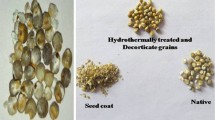Abstract
Hydrothermal treatment is one of the processes used to improve the milling quality of rice. Little millet is one the minor millet which is used as rice in India. The usage of little millet has been reduced because of problem in milling and higher breakage. In the present study an attempt was done to improve the milling yield and to reduce the breakage by applying hydrothermal treatment and conditions used were different soaking and steaming conditions. Whole little millet grain was soaked at different soaking temperatures of 60, 70 and 80 °C. The soaking time was 3 and 4 h followed by steaming at temperatures 100 and 110 °C for 15, 20 and 25 min. After drying, milling was done. The conditions were standardized by analyzing milling quality, cooking quality, colour values and consumer acceptability. Head rice yield was increased and breakage was decreased with increase in the soaking time, soaking temperature, steaming time and steaming temperature. Colour become darker, cooking time increased as time and temperature of soaking and steaming increased. When all other parameters considered the treatment with initial soaking temperature of 700 °C for 3 h and steaming at 1100 °C for 20 min was found to be optimum with 92.08 % head rice yield, 0.98 % broken, 17.66 min of cooking time, with 4.90 % leached solids and 3.30 g/g of water uptake. The treatment improved milling efficiency by increasing milling yield and reduced breakage.


Similar content being viewed by others
References
Anonymous (2009) Millet Network of India, Deccan Development Society, FIAN, India
Balasubramanian S, Vishwanath R, Sharma R (2007) Post harvest processing of millets: an appraisal. Agric Eng Today 31(2):18–23
Chandrasekara A, Shahidi F (2011) Determination of antioxidant activity in free and hydrolyzed fractions of millet grains and characterization of their phenolic profiles by HPLC-DAD-ESI-MSn. J Funct Foods 3:144–158
Chandrasekara A, Naczk M, Shahidi F (2012) Effect of processing on the antioxidant activity of millet grains. Food Chem 133:1–9
Chethan S, Malleshi NG (2007) Finger millet polyphenols: characterization and their nutraceutical potential. Am J Food Technol 2(7):583–592
Dharmaraj U, Malleshi NG (2011) Changes in carbohydrates, proteins and lipids of finger millet after hydrothermal processing. LWT Food Sci Technol 44:1636–1642
Geervani P, Eggum BO (1989) Nutrient composition and protein quality of minor millets. Plant Foods Hum Nutr 29:201–208
Heinemann RJB, Behrens JH, Lanfer-Marquez UM (2006) A study on the acceptability and consumer attitude towards parboiled rice. Int J Food Sci Technol 41:627–634
Islam RM, Shimizu N, Kimura T (2002) Effect of processing conditions on thermal properties of parboiled rice. Food Sci Technol Res 8(2):131–136
Itagi SK (2003) Development and evaluation of millet based composite food for diabetics II. Ph. D thesis, Univ Agric Sci, Dharwad, Karnataka
Kimura T, Bhattacharya KR, Ali SZ (1993) Discoloration characteristics of rice during parboiling (I): effect of processing conditions on the color intensity of parboiled rice. J Soc Agric Struct 24:23–30
Kotagi K (2011) Little millet (Panicum miliare) flakes: development, value addition, quality evaluation, consumer acceptability and commercialization. Ph.D. Thesis, Univ. Agric. Sci., Dharwad, Karnataka
Kulkarni LR, Naik RK, Katarki PA (1992) Chemical composition of minor millets. Karnataka J Agric Sci 5(3):255–258
Manful JT, Grimm CC, Gayin J, Coker RD (2008) Effect of variable parboiling on crystallinity of rice samples. Cereal Chem 85:92–5
Miah KMA, Haque A, Douglass MP, Clarke B (2002) Parboiling of rice (II): effect of hot soaking time on the degree of starch gelatinization. Int J Food Sci Technol 37:539–545
Otegbayo BO, Osamuel F, Fashakin JB (2001) Effect of parboiling on physico-chemical qualities of two local rice varieties in Nigeria. J Food Technol Africa 6(4):130–132
Padulosi S, Mal B, BalRavi S, Gowda J, Gowda KTK, Shantkumar G, Yenagi N, Dutta M (2009) Food security and climate change: role of plant genetics resources of minor millets. Indian J Plant Genet Resour 22(1):1–16
Parnsakhorn S, Noomhorm A (2008) Changes in physicochemical properties of parboiled brown rice during heat treatment. Agric Engineering Int the CIGR E Journal 10:1–20
Pradeep SR, Guha M (2010) Effect of processing methods on the nutraceutical and antioxidant properties of little millet (Panicum sumatrense) extracts. Food Chem 126:1643–1647
Raghavendra Rao SN, Juliano BO (1970) Effect of parboiling on some physicochemical properties of rice. J Agri Food Chem 18(2):289–294
Roy P, Shimizu N, Kimura T (2004) Effect of temperature distribution on the quality of parboiled rice produced by parboiling process. Food Sci Technol Res 10(3):254–260
Sareepuang K, Siriamornpun S, Wiset L, Meeso N (2008) Effect of soaking temperature on physical, chemical and cooking properties of parboiled fragrant rice. World J Agric Sci 4(4):409–415
Serna-Saldivar SO, Clegg C, Rooney LW (1994) Effects of parboiling and decortication on the nutritional value of sorghum (Sorghum bicolor L. Moench) and Pearl Millet (Pennisetum glaucum L.). J Cereal Sci 19:83–89
Srivastava S, Thathola A, Batra A (2001) Development and nutritional evaluation of proso millet-based convenience mix for infants and children. J Food Sci Technol 38(5):480–483
Ushakumari SR, Malleshi NG (2007) Small millets: Nutritional and technological advantages, In: Food uses of small millets and avenues for further processing and value addition, Ed. Krishnegowda K, and Seetharam, All India Coordinated Small Millets Improvement Project, ICAR, UAS, Bangalore
Acknowledgments
We sincerely acknowledge International Development Research Centre, Ottawa, Canada for the financial support provided through the Canadian International Development Agency (CIDA) Grant No. 106314-001 and DST, Govt of India, New Delhi for Fellowship.
Author information
Authors and Affiliations
Corresponding author
Rights and permissions
About this article
Cite this article
Mannuramath, M., Yenagi, N. Optimization of hydrothermal treatment for little millet grains (Panicum miliare). J Food Sci Technol 52, 7281–7288 (2015). https://doi.org/10.1007/s13197-015-1798-z
Revised:
Accepted:
Published:
Issue Date:
DOI: https://doi.org/10.1007/s13197-015-1798-z




